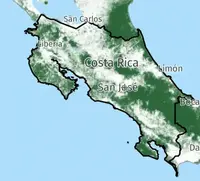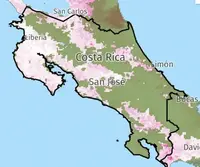Costa Rica Travel Guide
Comprehensive Guide for Herpers, Birders, and Ecotourists
Travel Guide to Costa Rica: A Paradise for Ecotourists
Introduction to Costa Rica

Costa Rica, a small Central American country bordered between Nicaragua to the north and Panama to the south, is a land of remarkable ecological and geographical diversity. The country is divided north to south by mountain ranges, including six active volcanoes, creating distinct Pacific and Caribbean sides that boast varied climates and ecosystems. Bordered by the Pacific Ocean to the west and the Caribbean Sea to the east, Costa Rica's idyllic location near the equator and forming a gateway between two oceans and two continents makes it a tropical paradise teeming with natural beauty.

Despite being a developing nation with about 20% of its population living below the poverty line, Costa Rica enjoys the highest living standard in Central America and is frequently ranked among the happiest countries in the world. This high quality of life can be attributed to close family ties, low levels of violent crime and government corruption, and excellent social programs, including government-supported healthcare and education, which has led to a literacy rate exceeding 97%.

Costa Rica is a stable democratic republic with strong ties to the United States, which is its largest trading partner and a major source of tourism and investment. Known for its commitment to environmental protection, the country is a global leader in limiting carbon emissions and is committed to preserving its natural resources, including its rainforests, flora, and fauna. While tourists should exercise standard precautions against petty crime, Costa Rica is generally considered a safe destination, welcoming millions of visitors each year who come to explore its rich biodiversity and charasmatic culture.
Understanding Costa Rica: Geography, Climate, and Biodiversity
Exploring Costa Rica’s Diverse Geographic Regions
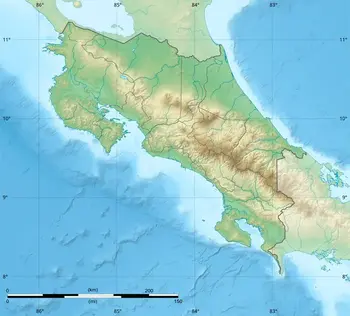
The varied geography of Costa Rica contributes to its relevence as a world famous ecotourist hotspot. Despite Costa Rica's small size, the country boasts significant geographic diversity due to extreme variations in elevation and distinct weather patterns influenced by its two bordering oceans. The country is divided from northwest to southeast by high-elevation mountain ranges that support a range of habitats, from lush rainforests and misty cloud forests to alpine environments above the tree line. These mountain ranges create three distinct regions: the eastern Caribbean side, the western Pacific side, and the high-altitude central region. Both the Caribbean and Pacific sides are dominated by rainforest ecosystems, receiving abundant rainfall—between 100 and 300 inches annually. However, the Pacific northwest region, particularly Guanacaste province, experiences a much drier climate with less than 60 inches of annual rainfall, supporting tropical monsoon forests and savannahs. Wildlife enthusiasts can categorize Costa Rica into four main regions: the Caribbean rainforests, the southwestern Pacific rainforests, the high-altitude mountainous areas, and the drier Guanacaste region. Each region supports unique flora and fauna, with some species, like the lowland inhabiting eyelash viper (Bothriechis nigroadspersus), found in both Caribbean and Pacific rainforests, while others, such as the high-altitude black-speckled palm-pit viper (Bothriechis nigroviridis), side-striped palm pitviper (Bothriechis lateralis) and the Talamancan Palm-pit viper (Bothriechis nubestris), are restricted to specific environments.
Exploring The Unique Provinces and Ecological Zones of Costa Rica

Costa Rica is politically divided into seven provinces, each with distinct ecological and climatic characteristics. Guanacaste, in the extreme northwest, is the driest region, supporting tropical monsoon forests and savannahs. To the east lies Alajuela province, which stretches from the Nicaraguan border in the north to the central highlands surrounding the capital, San José. Alajuela features lowland rainforests, the famous Arenal Volcano, and the Monteverde and Santa Elena cloud forest reserves. East of Alajuela is Heredia province, home to the high-elevation rainforests of Braulio Carrillo National Park and mid-elevation ecolodges such as Yatama Ecolodge and La Selva Biological Station. Southeast of Heredia is Cartago province, known for its vast agricultural lands, active volcanoes like Turrialba, and remote rainforests in the southeast. Limon province covers the entire eastern coast, featuring lowland rainforests, Tortuguero National Park, and the biodiverse Talamanca Mountains. San José province, located in the central highlands, includes the capital city and stretches southward along the continental divide, encompassing the country's highest peak, Cerro Chirripó. Lastly, Puntarenas province runs along the Pacific coast from Guanacaste in the north to Panama in the south, with the Osa Peninsula in the south hosting the world-renowned Corcovado National Park, one of the most biodiverse areas on Earth.
Costa Rica Weather Patterns:
Best Times for Birding, Herping, and Exploring
Situated well within the tropics, Costa Rica experiences two main seasons: a wet season and a dry season, corresponding to the summer and winter months of the Northern Hemisphere, respectively. The wet season, which runs from mid-May through November, is the best time for wildlife viewing, especially for herping (reptiles and amphibians), as the humid conditions are ideal for their activity. This period coincides with the low season for tourists, offering less crowded conditions and often lower prices for lodging and services. The dry season, from December to mid-May, is the peak tourist season, attracting visitors seeking sunny weather. However, when planning a visit, it's important to note that terms like "summer" and "winter" in Costa Rica may refer to the dry and wet seasons, which can be confusing. Rainfall varies significantly across the country, from 60 inches in the driest regions of Guanacaste to over 280 inches in the wettest areas, such as the Osa Peninsula. While the Pacific side has a distinct wet and dry season, the Caribbean side experiences more consistent rainfall year-round, making it a viable option for wildlife viewing even during the dry season. The Guayacán rainforest region on the Caribbean side, in particular, recieves abundant rainfall all year round with yearly averages ranging from 197 to 236 inches (5-6m) and a record of 308 inches (7.8m) in 2015 (Brian Kubicki).
Costa Rica’s Rich Biodiversity

Despite covering just 0.03% of Earth's landmass, Costa Rica is home to approximately 4% of the planet's species, making Costa Rica one of the most biodiverse countries in the world, including hundreds of endemic species. But why does Costa Rica have so much biodiversity? Costa Rica's intense biodiversity results from Costa Rica's unique geographical and climatic conditions, which create a wide range of habitats across the country. The tropical, wet climate, combined with an elevation range from sea level to over 12,000 feet, fosters diverse ecosystems, from tropical lowland rainforests and mangrove swamps to cloud forests and high-altitude paramo. Additionally, Costa Rica's location between the Pacific Ocean and the Caribbean Sea brings distinct climate influences from each, further enriching its ecological diversity. Positioned at the intersection of North and South America, Costa Rica is home to species typical of both continents, contributing to its remarkable variety of flora and fauna.
Discovering Costa Rica’s Ecosystems:
Rainforests, Cloud Forests, and More
Costa Rica's diverse ecosystems range from below sea level to high-altitude environments over 12,000 feet. The country features coral reefs in both the Pacific and Atlantic Oceans, extensive beaches, and mangrove wetlands along its coasts. Inland, lowland rainforests transition into tropical monsoon forests and savannahs in the dry northwest. As one moves further inland, the flat lowland rainforests give way to extremely diverse rainforests on the lower foothills, which host species typical of both low and higher elevations. At higher elevations, the flora and fauna change with altitude and temperature. The cloud forests, found along the high mountain ridges, are some of the rarest and most threatened biomes on Earth. At the highest elevations, tropical trees give way to a neotropical high-altitude grassland, where cold temperatures, occasional frosts, and intense winds create a unique environment for specialized species.
Costa Rica’s Iconic Wildlife:
Essential Sightings for Herpers, Birders, and Ecotourists

Costa Rica is home to an array of iconic species that captivate nature enthusiasts and underscore the country’s incredible biodiversity. Among these are the vibrant red-eyed tree frogs, known for their striking appearance and nocturnal habits, and the slow-moving sloths, which are a favorite sight in the rainforest canopy. The elusive jaguar, the largest cat in the Americas, roams the dense jungles, while colorful toucans, with their oversized bills, add splashes of color to the forest.
The country also harbors the endangered Baird's tapir, a unique mammal that thrives in Costa Rica's protected areas, and species more commonly found on the South American continent, such as marsupial opossums and xenarthrans like sloths, armadillos, and anteaters. Costa Rica is also famous for its diverse snake population, including the bright yellow eyelash viper and other striking species in the Bothriechis genus. The country’s four species of monkeys—howler, spider, squirrel, and capuchin—are frequently spotted in national parks. Additionally, Costa Rica's beaches are critical nesting sites for sea turtles, where the spectacular arribada event occurs, during which thousands of olive ridley sea turtles simultaneously come ashore to lay their eggs, creating one of nature’s most awe-inspiring phenomena.
Local Culture and Language
Understanding Costa Rican Culture and Traditions as an Ecotourist

Costa Rican culture is a rich blend of indigenous traditions, Spanish colonial influence, and modern global trends, all centered around the "Pura Vida" philosophy, which embodies a positive, laid-back approach to life. Ticos, as Costa Ricans are known, deeply value family, community, and the natural beauty of their country. Catholicism plays a significant role in daily life and is reflected in vibrant festivals and traditions like "Fiestas de Palmares" and "Semana Santa" (Holy Week). Spanish is the official language, though English is widely spoken in tourist areas, making it easier for visitors to connect with locals and immerse themselves in the culture.
Understanding and respecting local customs
While a comprehensive overview of Costa Rican culture and customs is beyond the scope of this article, doing some additional research will be beneficial. In a nutshell, Ticos are immersed in Western culture and are accustomed to interacting with American and European tourists, making them understanding and tolerant of different cultures. However, taking the time to learn and respect their customs will be greatly appreciated by locals. As the saying goes, "When in Rome, do as the Romans do."
Do You Need to Know Spanish for Your Costa Rican Ecotourism Adventure?
Before my first visit to Costa Rica, I was concerned that my limited Spanish skills (I knew just the basics) would leave me struggling if something went wrong. Friends assured me that everyone in Costa Rica speaks English, but I was skeptical—and rightly so. While many service workers in tourist areas do speak English, if you’re like me and prefer to explore more remote regions, you’ll find that English is less commonly spoken. In my experience, most Costa Ricans I encountered did not speak English. However, my fears about not knowing the language were largely unfounded.
Even when language barriers existed, the Costa Ricans I met were incredibly patient and eager to communicate, even if it meant relying on single words, gestures, or pantomime. It’s remarkable how effective non-verbal communication can be!
For non-Spanish-speaking visitors, I recommend learning as much Spanish as possible before your trip, but don’t let language limitations discourage you from visiting Costa Rica. Language learning apps like Duolingo and Babbel are a fun and convenient way of building your vocabulary and understanding of basic sentence structure. The more Spanish you learn, the smoother your experience will be, and I found that Ticos genuinely appreciated my efforts to speak their language. My Spanish was far from perfect, but I could tell that locals appreciated my attempt.
Make an effort to learn key phrases and nouns that will be useful during your trip, especially terms related to travel (like "taxi," "bus," and the names of towns) and the Spanish names for any species you’re hoping to spot. I also recommend downloading Google Translate to your phone for quick reference—Ticos are usually patient while you type in a translation, and many use the app themselves! Below, you'll find a table of key phrases and nouns that should come in handy in Costa Rica
Before you travel, try brushing up on your Spanish with a language app such as Babbel or Duolingo to give you extra confidence when navigating daily interactions in Costa Rica. While you're in Costa Rica, have a translate app, such as Google Translate, on your phone to help with words and phrases you don't know.
Preparing for Your Costa Rica Adventure
Essential Travel Documentation for Ecotourists in Costa Rica
When you arrive at customs in Costa Rica, you will likely be asked for your passport, proof of onward transportation, your intended length of stay, and the address of your first accommodation. You can verbally communicate your length of stay and where you’ll be staying to the customs officer (if you’re staying at multiple locations, simply mention the first one). If you are a U.S. citizen planning to stay for less than 180 days, you will not need a visa, but you will need a valid passport that is good for at least one day beyond your entry date and has at least one blank page for a stamp. You will also need to provide proof of your departure from the country, which is most easily done by showing your return flight ticket. Alternatively, a pre-purchased bus or flight ticket out of Costa Rica can serve as proof of onward travel.
You may also need proof of economic means, i.e. you need to have at least $100 USD per month to stay in Costa Rica. Not everyone is asked this, and it seems like visitors from the U.S., Canada, and Europe likely will not be asked. For more official information for U.S. travelers, please visit the Costa Rica Embassy site or the U.S. State Department site.
Disclaimer: It is essential to conduct your own research using official and reliable sources to determine the travel documentation required for your specific circumstances and travel dates. The information provided above may not be accurate for your situation and could be outdated.
Vaccinations for Traveling to Costa Rica
For those planning a trip to Costa Rica, ensuring you are up to date with certain vaccinations can greatly enhance the safety and enjoyment of your journey. According to the Centers for Disease Control and Prevention (CDC), travelers should ensure they are up to date on routine vaccines, including measles-mumps-rubella (MMR), diphtheria-tetanus-pertussis, varicella (chickenpox), polio, and the yearly flu shot. Additionally, vaccines for Hepatitis A and Typhoid are recommended due to potential exposure through contaminated food or water, even though Costa Rica generally has very safe drinking water straight from the tap.
According to the NHS, Malaria is uncommon throughout Costa Rica and throughout the year. However, according to the CDC it is known to exist in the provinces Alajuela and Limón, while transmission is rare to nonexistent in other parts of the country. Unlike some other tropical destinations, the Yellow Fever vaccine is not recommended for travel to Costa Rica.
Personal Experience and Recommendations
For those hesitant about the upfront costs of vaccinations, consider that most vaccines provide long-lasting protection, often for many years or even a lifetime, making them a one-time investment that won't be necessary on subsequent trips. In addition to the recommended vaccines from your home country, Hepatitus A, Tetanus, and Typhoid are often recommended for traveling to tropical regions of the Americas. These vaccines are relatively affordable, have minimal to no side effects for most people, and quickly become effective.
Additionally, I recommend purchasing and packing medication for travelers' diarrhea, which can result from bacterial, parasitic, or viral infections, but might also occur simply due to dietary changes. Anti diarrheal medications such as ZITHROMAX (azithromycin) can be purchased beforehand and carried during the trip to be used as needed, or saved for future travels if they remain unused.
Travelers often have mixed opinions about malaria pills. These are generally expensive and can have side effects. While malaria is typically uncommon in Costa Rica, each traveler should do his or her own research on the specific regions visited, consider consulting with a doctor or travel clinic, and to assess his/her own risk acceptance. Regardless of the presence of malaria or other mosquito tramsmitted diseases, travelers should take precautions to minimize exposure to mosquito bites. Mosquito prevention measures such as using DEET-containing repellents and treating outer clothing and gear with permethrin (available at outdoor outfitters like REI or the camping sections of big-box stores like Walmart) are essential.
The need for the rabies vaccine (pre-exposure prophylaxis) often sparks debate among travelers due to its perceived low risk. Most people, world-wide, are unlikely to be exposed to rabies, and exposure is not necessarily more likely while traveling than it is at home. Most people, therefore, opt out of pre-exposure prophylaxis. However, rabies is extremely serious and nearly always fatal once symptoms appear, requiring immediate post-exposure treatment—even for vaccinated individuals. The main drawbacks of the vaccine include its cost, the inconvenience of receiving three doses, and it doesn't eliminate the need for immediate post-exposure treatment. Ultimately, whether to get vaccinated against rabies depends on one's personal risk tolerance and specific travel plans. Travelers who handle bats, work closely with potentially rabid wild mammals or dogs will have a higher risk and should consider it essential and discuss their risks with a healthcare provider.
It’s important to note that the above recommendations are based on my personal (nonprofessional) experience, research, and risk tolerance, and may not reflect the views of the CDC or the broader medical community. All travelers should conduct their own research, consult resources like the World Health Organization (WHO) or health organization of your own country such as the CDC in the U.S.A, the NHS in the U.K. etc., and seek advice from a specialized travel clinic (such as Passport Health in the U.S.) which offers expert guidance tailored to specific travel destinations. Ultimately, the choice of what precautions to take are up to you and depend on your own risk tolerance.
Pro tip: Often, pharmacies can provide some medications at lower costs than travel clinics can, and some vaccinations, especially non-travel specific vaccines such as flu or covid can be obtained cheaper or free at pharmacies, walk-in clinics, or in-network health providers.
It's important to consult with a healthcare provider or a travel health clinic well in advance of your trip, as vaccines require some time to become effective. The clinic can provide the most current advice and recommendations based on your individual health and travel itinerary. This tailored guidance ensures that you receive only the necessary vaccinations and health advice for your specific destinations within Costa Rica.
Travel Insurance and Health Considerations
When planning your trip to Costa Rica, it’s crucial to consider travel insurance and health-related preparations to ensure a safe and worry-free experience. While Costa Rica is known for its excellent healthcare system and is generally a safe destination, unforeseen circumstances such as accidents, illness, or travel disruptions can occur anywhere. Securing comprehensive travel insurance that covers medical expenses, trip cancellations, and other potential issues provides peace of mind and is highly recommended, even for budget travelers. Travel insurance is relatively inexpensive and should be considered a "must" for all travelers. I personally use Allianz travel insurance. While I’ve been fortunate never to have made a claim, the process of acquiring the insurance was straightforward and very affordable, offering excellent coverage and benefits. They even provide a concierge telephone service that can assist with issues like disrupted travel plans or offer advice on entertainment, accommodations, currency exchange, and more.
Additionally, being aware of local health considerations—such as recommended vaccinations, staying hydrated, and knowing where to access medical care—will help you fully enjoy your adventure while minimizing risks.
Can you drink the tap water in Costa Rica?
Quite simply, yes, you can safely drink the tap water in Costa Rica. I drank tap water while in Costa Rica, from San Jose, to the Caribbean, to the Pacific, to the mountains and, to remote ecolodges that collect rain for drinking water, and I never had an issue with the water. That being said, not every locality has the same water source, so if you’re ever in doubt, you can ask the locals, or just stick to bottled water.
Food: Groceries and Restaurants

Supermarkets (supermercados) can be found in larger towns and cities, while smaller stores are available in nearly every small town. Although buying groceries is generally cheaper than dining out at restaurants, many Western visitors to Costa Rica are surprised by how expensive groceries can be. Despite Costa Rica's lower median income compared to the U.S. and Europe, grocery prices are often comparable to those in the United States. While locally sourced produce can be affordable, imported brands typically come with a premium price tag.
Grocery stores in small towns will have a more limited selection than those in larger urban areas, but you should still be able to find essential items like milk, juice, eggs, potatoes, and some fresh produce, allowing you to maintain a healthy diet. However, fresh meat may not always be readily available, and you might need to settle for frozen or processed meat products.

When eating out, Costa Rica offers many small, family-owned restaurants called sodas, which serve traditional Costa Rican meals at reasonable prices. Staples include rice and beans (gallo pinto), plantains (plátanos), and a variety of local fresh fruits, along with meats such as beef, pork, chicken, and fish. If you have a sensitive stomach, you might want to be cautious when eating at sodas—not necessarily due to food contamination, but because a sudden change in diet can sometimes lead to stomach upset or diarrhea.
Packing Tips for Ecotourists in Costa Rica
In this section, I’ll provide a brief overview of essential items that wildlife enthusiasts should pack for their trip.
First and foremost, Costa Rica is a wet environment. If you visit during the rainy season, you will get rained on. Even in the dry season, rain is still a possibility. Staying completely dry while hiking in the hot, humid, low-elevation rainforests is almost impossible. Whether from rain, sweat, or brushing against wet foliage, you’ll likely end up soaked. However, the warm temperatures mean you don’t have to worry about getting too cold. Since staying dry might be difficult, the goal should be to stay comfortable when wet. I strongly recommend wearing only synthetic fabrics or wool, as they dry much faster than cotton, which can take several days to dry in the humid air—plus, dryers are uncommon.
Every hiker should carry a lightweight poncho in their pack. Ponchos are inexpensive, lightweight, and can be compressed to a small size, making them easy to carry, even in a pocket. In the steamy lowland rainforests, getting rained on may not chill you much and can even be a welcome relief from the heat. However, a poncho will be invaluable during a torrential downpour, which is common in the rainy season.
To protect your camera gear, electronics, passport, and money from getting wet, I strongly recommend using a dry bag and placing smaller items in plastic sealable bags inside your pack. I also find it handy to bring large yard waste garbage bags that can cover entire suitcases and luggage in the event of a downpour.

Rubber boots are essential for rainforest hikes during the rainy season. I personally recommend wearing knee-high, thin wool socks with your boots. The knee-high socks will prevent the tops of the boots from rubbing against your skin, and you can wear shorts for breathability while still covering your legs for protection. Wool dries faster than cotton and insulates better when wet.
At higher elevations, such as in the cloud forests, where the air is cooler and often breezy, staying dry is more attainable, and you’ll want to stay dry to keep warm. I recommend wearing synthetic fiber clothes and carrying a poncho. Rubber boots may not be necessary here, especially on popular, well-maintained trails. Water-resistant hiking boots or even trail runners may suffice. For example, the trails in the Monteverde Cloud Forest Reserve and Curi-Cancha Reserve are wide, well-worn, and well-drained, making rubber boots unnecessary. Additionally, sandy trails near the ocean, such as those in Cahuita National Park, Manuel Antonio National Park, and possibly Corcovado National Park, may not require rubber boots either. In the cooler cloud forests, you’ll likely want to bring warmer clothes, such as pants, a sweater, and a windbreaker.
Don’t forget to pack personal items like toiletries, sunscreen, mosquito repellent, and spare batteries. Since Ticos don’t often use sunscreen or mosquito repellent, these items might not be available at every store, and when they are, they can be quite expensive. Also, be sure to bring specialized items like camera batteries, memory cards, and any accessories specific to your brand, make, or model. Despite the high number of tourists visiting Costa Rica, you can’t always rely on finding a camera store with the items you need, and certain electronics may only be available in San José.
Finally, be sure to bring flashlights, whether you plan on night hiking or not. Costa Rica’s tropical latitude means you’ll have 12 hours of darkness each day. If you’re planning on night hiking, which I highly recommend, you should carry at least two lights with you, each with fresh batteries. Having two lights and spare batteries is essential—you don’t want to be without light in the rainforest. The canopy of primary forests blocks nearly all star and moonlight, making it nearly impossible to see without artificial light. I recommend carrying one headlamp and one handheld LED light, along with spare batteries and chargers.
Packing Camera Equipment for Costa Rica Wildlife Photography
In this section, I’ll provide a brief overview of the essential camera equipment to bring to Costa Rica. All photographers should bring several camera batteries and chargers, as well as multiple data storage cards. This isn’t just because you’ll be taking lots of photos, but also as a safeguard against theft, damage, or malfunctions—spreading your photos across multiple cards ensures you don’t lose everything at once. Additionally, a flash is a must-have. Even during the day, overcast skies and dense canopies can significantly reduce ambient light, making a flash essential, especially for macro photography.
Herpetology Photography

If you’re focusing on reptiles, amphibians, and invertebrates, you’ll want to bring a macro lens and/or a wide-angle lens for close-up shots, a flash, and a flash diffuser. Even if you prefer natural light photography, the low light levels in the forest often make flash photography necessary to capture clear, detailed images.
Birding Photography

Birding in Costa Rica will require the same lenses and tripods you typically use for bird photography. However, the low light conditions you’ll likely encounter in Costa Rica mean you may need faster lenses to capture as much light as possible. You might also consider adding a flash to your setup to improve your chances of getting the perfect shot
General Wildlife Photography
For general wildlife photography, whether you’re looking to capture sloths, toucans, or reptiles and amphibians, a long lens is essential for birds and mammals, while a macro and/or wide-angle lens is ideal for closer subjects like reptiles, amphibians, invertebrates, and plants. A flash with a diffuser is usually necessary for macro photography, even during the day, and a flash without the diffuser can be used with the long lens. For a long lens, I recommend a 400mm or 500mm prime lens. The advantage of fixed focal length prime lenses, such as the Nikon 500mm PF lens (f/5.6), is that they are weather-sealed (perfect for the rainforest) and are lighter and more compact than their zoom lens counterparts.
Cell Phone Use in Costa Rica
When traveling to Costa Rica, staying connected via cell phone and data services is straightforward, with several options available to suit different needs and preferences.

Buying SIM Cards in Costa Rica
One popular option is purchasing a local SIM card, which provides access to domestic rates for calls, texts, and data. This is often the most cost-effective way for international travelers to use their phones in Costa Rica. Major mobile service providers include Kölbi, Claro, and Movistar, with Kölbi being the most widespread and generally offering the best coverage, especially in rural areas. SIM cards are readily available at kiosks or in stores in most market places in most towns, just look for the ubiquitous red Claro signs or a Kölbi sign accompanied with their frog logo. The biggest downside to buying a SIM card is the need for an unlocked quad band phone that has a physical SIM card (not an electronic SIM). This option also may require changing your usual number temporarily, which might be inconvenient for some.
What is an unlocked phone? An unlocked cell phone can be used with multiple service providers, while a locked phone is tied to a specific carrier. Unlocked phones are more flexible and can be used with any compatible network, including international carriers. To find out if your phone is locked or unlocked, you can check your phone's settings. For example, on an iPhone, you can go to Settings, then Cellular, then Cellular Data. If you see "Cellular Data Network", your phone is probably unlocked. You can also consult your carrier's unlocking policy for more information.
The biggest advantage of buying a SIM card is cost-effectiveness. Local rates are significantly cheaper than most international plans, and having a local number can be beneficial for reservations and local contacts. According to information from MyTanFeet.com as of 2024, travelers can find a Claro kiosk at the San Jose International Airport (SJO), positioned to the left of Baggage Claim 5. This kiosk operates from 6 AM to 9 PM, extending hours until 11 PM on weekends. The staff at this location will assist you with purchasing a SIM card, and can also help with inserting it and setting up your phone. Claro provides several plan options, including a 15-day plan for $60 USD and a 7-day plan for $30 USD. Additionally, there is a vending machine available from which you can directly purchase a SIM card, and you can request help from an agent to install it in your phone.
Burner Phones
For those who prefer not to use their personal devices or need a temporary phone solution, burner phones (cheap prepaid cell phones with no commitments or contracts required) are available for purchase. These can be found in many of the same places as SIM cards, including most market places in most towns throughout Costa Rica. Burner phones provide basic functionalities and are pre-loaded with a set amount of calling and texting capabilities, making them a secure and straightforward option. Burner phones provide a degree of privacy and simplicity, ideal for travelers who may not want to use their personal device overseas. However, they can be limited in functionality and might not include data service, which is a drawback for those needing internet access on the go. They also don't have all the apps, files, and functionalities that you're used to having on your personal phone.
International Plans
For travelers from the United States, particularly those already using AT&T, the AT&T International Day Pass is highly recommended. This plan allows you to use your current plan in Costa Rica for $10 per day (as of 2023), charged only on the days you use it. This option is perfect for those who need to stay connected with their usual number and service but don’t want the hassle of changing SIM cards. It offers convenience and reliability, though it can be more costly compared to local SIM cards if used extensively.
Personally, this is the option I used on multiple trips to Costa Rica. I mostly just used cell/data service when I was traveling from one in-country destination to another, so that I could use my phone to call home, call the lodge I was staying at, use navagation apps, and access the internet. When I wasn't travelling, I'd remove my SIM card and place it the safe waterproof pouch I kept my passport in, so that I could still use my phone for photos and other apps not requiring cell or data service, and not worry about accidentally triggering the daily fee.
For the most up to date information on cell phone strategies in Costa Rica, consult the following excellent Costa Rica travel blogs: MyTanFeet.com and TwoWeeksInCostaRica.com.
Staying Connected: Calling and WhatsApp in Costa Rica
To make a phone call in Costa Rica, you’ll need to know both the local dialing system and how to call internationally. Costa Rica’s country code is +506, and unlike many countries, it has no separate area codes—all phone numbers are eight digits long. Mobile numbers usually begin with an 8 (sometimes 7 or 6), while landlines start with a 2 (for the Central Valley) or 4/5 in other regions. When calling from abroad, dial your country’s international access code (e.g., 011 from the U.S. or Canada), followed by 506 and then the eight-digit number (for example, 011-506-8888-8888). Within Costa Rica, you simply dial the eight-digit number directly—no prefixes required. Because most locals and businesses rely heavily on WhatsApp, you’ll often find that numbers listed online or given by hotels and tour operators are WhatsApp-enabled, making it the easiest and cheapest way to call or message once you’ve saved the contact with the +506 country code.
WhatsApp is the primary way to contact people and businesses in Costa Rica, from arranging tours to chatting with your hotel. To add a Costa Rican number in WhatsApp, save it in your phone’s contacts with the country code +506 followed by the eight-digit local number (for example: +506 8888 8888 for a mobile, or +506 2222 2222 for a landline). There are no area codes in Costa Rica, so the format is always +506 plus the eight digits. Once saved, you can call, message, or video chat over Wi-Fi or mobile data without paying international calling fees. Most tour operators, lodges, and even taxi drivers will expect to communicate this way, so it’s a good idea to confirm WhatsApp contact details when making reservations.
Note: WhatsApp calls do not use your phone plan’s minutes – they strictly use internet. So even if you call a local number via WhatsApp, it doesn’t count as a traditional phone call at all. Conversely, you cannot call a regular phone number through WhatsApp unless that number is registered on WhatsApp. For example, you can’t dial a hotel’s landline via WhatsApp; you’d need to call normally or see if the hotel has a WhatsApp contact number (many do). WhatsApp is a closed network – both parties must be on WhatsApp.
Tip: Connect to wifi, if available, before using your whatsapp.
Transportation to and Within Costa Rica
Getting around Costa Rica is relatively straightforward, with a variety of transportation options to suit different needs and budgets. Whether you prefer the convenience of renting a car, the affordability of public buses, or the efficiency of domestic flights, understanding your options will help you navigate the country with ease and make the most of your adventure. Most areas are easily accessible by ground transportation, with only a few places, such as the Osa Peninsula, where a domestic flight might be preferable.
International Travel
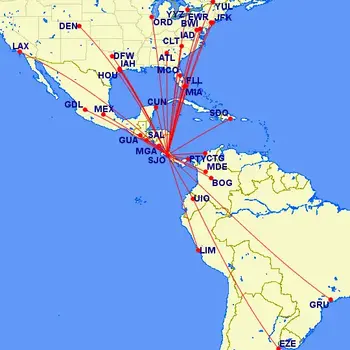
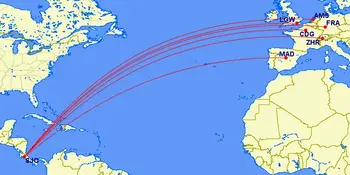
International travel to Costa Rica is primarily via flights into and out of Juan Santamaría International Airport (SJO) in Alajuela, just outside the capital city of San José. The other international airport is in Liberia, located in the Guanacaste province.
From San José, a variety of ground transportation options are available, including taxis, limousines, and buses. While Uber is commonly used, it’s important to note that it is not legal in Costa Rica at the time of writing. From my personal communtication with locals who use Uber, your driver will often request that you meet him/her at a specific location, and greet each other as friends would, in an attempt to fool authorities into thinking you are friends.
Domestic charter flights from Juan Santamaría Airport offer fast travel to regions such as Limón on the Caribbean coast, Guanacaste, and Puerto Jiménez on the Osa Peninsula.
Ground Transportation: Car Rentals vs. Bus/Taxi
If you’ve decided on ground transportation, the next decision is whether to rent a car or rely on buses and taxis. Buses and taxis are very affordable, reliable, and serve nearly every town in Costa Rica, no matter how small. Renting a car is convenient, quick, and provides ultimate freedom in travel, however, it is likely to be considerably more expensive than bus/taxi, even when taking frequent taxi rides.
Pros and Cons of Bus Travel
Traveling by bus is the cheapest option, especially for small groups. From the capital, San José, you can reach nearly any popular destination for less than $10 USD. Express routes can be surprisingly quick (my bus driver from San José to Siquirres drove much faster than I would have!). The biggest advantage of bus or taxi travel (as opposed to driving yourself), besides cost, is not having to worry about driving or navigating unfamiliar roads in a foreign country. The main downside of bus travel is the extra time required—taking a cab to the bus station, waiting for the bus, and then taking another taxi to your final destination. If you plan to visit multiple destinations, renting a car might save you time, which can be invaluable on vacation. However, if you’re only visiting two locations per week, bus/taxi travel might be the better option. As a rule of thumb, limit your destinations to minimize travel time. Costa Rica does not have the fast highways that Americans and Europeans might be used to, and short distances can take a surprisingly long time to travel. Estimate travel time using a navigation app like Waze, and then double it to account for slow-moving trucks and unexpected construction—common occurrences in a country that experiences torrential downpours.
Pros and Cons of Car Rentals
The advantages and disadvantages of renting a car are more pronounced than with other ground transportation options. The primary benefit is the freedom and time saved from not having to wait for cabs or buses. If you have many destinations on your itinerary (more than two per week) or want to explore remote areas, renting a car may be the most practical option. However, there are significant downsides, including higher costs, the responsibility for accidents or theft, and the burden of navigating and driving yourself in an unfamiliar foreign country.
At the time of writing, you should expect to pay about $600 per week for the most economical vehicle (a two-seater with manual transmission) during the rainy season. Costs increase for larger vehicles, 4WD, automatic transmission, additional insurance, low availability, and during the peak season (December-April). A large, 4wd, automatic SUV, with extras such as wifi and gps, during the peak season could be around $1400/week. If you are renting during the peak season, especially during Christmas, Easter, and New Years, be sure to book well in advance (months).
Be aware that Costa Rican car rental companies are notorious for not disclosing the true final cost upfront. Even after multiple inquiries, the price quoted may be much lower than what you’ll actually pay when picking up the vehicle*. Additionally, factor in the cost of gas, which may be higher than what you're used to, e.g. gas was 73% more expensive in Costa Rica than in my hometown of Colorado, U.S.A., at the time of writing. Note that the price of gas is controlled by the government and all gas stations should have the same price.
Another downside to renting a car is the process of handling accidents. Even a minor fender bender requires you to wait for the police and possibly an insurance agent to assess the damage. A small accident can end up costing you significant time. If your vehicle has any damage upon return, such as a windshield chip, allow plenty of extra time before your return flight, as you’ll need to wait for an insurance agent to inspect the vehicle before your deposit is returned.
Finally, driving in Costa Rica can be challenging. Although Costa Ricans drive on the right side of the road and follow similar rules and signage as in the U.S., navigating unfamiliar roads can be intimidating, especially when Ticos tend to drive unusually fast, even during torrential downpours on winding mountain roads. While I didn’t have any issues during my trip, I can’t deny that having a professional bus/taxi driver take the wheel is a significant weight off your shoulders.
Car Rental Requirements in Costa Rica:
- Passport (valid)
- Valid Driver's License from Home Country (International driver's license not required for licenses from U.S.A., Canada, Europe, and most countries with Latin alphabets)
- Credit Card with Funds Available for Security Deposit
- Minimum Age (21-25) Dependent on Company
- No photocopies of documents are acceptable.
- Make sure you don't reserve a manual transmission vehicle if you cannot drive manual transmission.
- Don't believe advertised prices that are too good to be true. A reputable company is better than a bargain company (and, ironically, often the same final price).
- Suzuki Jimni (manual transmission) are affordable, rugged, 4wd, and perfect for 1-2 people.
- Carry coins (in local currency, Colones) for tolls and parking attendants.
- Use local currency (Colones) or credit card for gas.
Domestic Flights
| Airline Departures from San José | ||
| Destination City | Airline | |
| Inland | La Fortuna | Sansa, Skyway |
| San Isidro | Sansa | |
| Liberia | Sansa, Skyway | |
| Palmar Sur | Sansa | |
| Pacific | Nosara | Sansa, Green Airways |
| Tamarindo | Sansa, Skyway | |
| Tambor | Sansa, Skyway | |
| Puerto Jiménez | Sansa, Skyway, Green Airways | |
| Manuel Antonio/Quepos | Sansa, Skyway, Green Airways | |
| Golfito | Sansa | |
| Drake Bay (Bahia Drake) |
Sansa, Skyway | |
| Cobano (Osa) |
Green Airways | |
| Caribbean | Limón | Sansa |
| Tortuguero | Sansa | |
For travelers with a larger budget, especially those with a large group and limited baggage, charter flights can be a convenient option. Several companies, including Sansa, Skyway, and Green Airways, offer flights to various parts of the country. Visitors to the Nicoya Peninsula, Osa Peninsula, and Tortuguero can save considerable travel time by flying. Be sure to book your flights well in advance and be aware of luggage weight restrictions.
Taxi
Taxis are common in most areas, even small towns, and are easily recognized by their red exterior with a yellow triangle. Estimating prices can be difficult due to variable travel times caused by traffic and construction, but the Rome2Rio app can provide reasonable estimates. A good practice is to ask your driver for an estimate before starting your journey. In San José, drivers are required to use a meter, though some may be open to bargaining. Outside of San José, meters may not be used, so always agree on a price before starting your trip (bargaining is acceptable). Typically, $1 per kilometer is more than enough in most situations, but remember that the driver may have to make the return trip unpaid, especially if you’re being driven to a remote area.
Tipping is generally not required or expected, but drivers may not always have change, so carry small bills to get as close to the fare as possible. Tipping may be necessary or appreciated if your driver goes above and beyond, such as waiting while you shop for groceries or stopping for photos. Remember the adage "cash is king." With cash, good bargaining skills, and decent manners, you can get nearly whatever service you need—just remember the goal is a mutually beneficial arrangement, not to take advantage of a hard-working person.
Bus
If you plan to use buses for ground transportation, your first task after arriving at Juan Santamaría International Airport (San José Airport) will be to get to one of the main bus stations in San José. The airport is actually located in the city of Alajuela, just outside of San José. The easiest option is to take a cab from the airport to a bus station in San José, which typically costs between $20-30 USD. Alternatively, you can take a bus into San José. To find the airport bus stop, exit the airport and look for the parking garage directly in front of you. Head to the opposite side of the garage and then to your left (west). You’ll see the bus stop there. Be sure to board the correct bus heading to San José, not the one going into downtown Alajuela.
Stay on the bus until you reach the Tuasa terminal in downtown San José, located across from a large city park, Braulio Carrillo Colina. From there, you’ll need to make your way to one of the six main bus stations in the city. You can do this by city bus, taxi (recommended), or walking (not recommended).
Use the tables below to find the San José bus terminal you need based on your destination. For return trips from your destination back to San José, simply reverse the route you took from San José. While some routes from San José to your destination may require intermediate stops and terminal changes, many return routes to San José offer express, non-stop service.
| Bus Stations and Routes from San José | ||||
| Destination City | Route | Total Cost (USD) | ||
| Caribbean | Cahuita | 1. Gran Terminal del Caribe San José to Limón 2. Terminal Mepe Limón to Cahuita |
7-13 | |
| Puerto Viejo de Talamanca | 1. Gran Terminal del Caribe San José to Limón 2. Terminal Mepe Limón to Puerto Viejo |
8-15 | ||
| Siquirres | Gran Terminal del Caribe San José to Siquirres. | 3-6 | ||
| North | Monteverde | Terminal 7-10 San José to Monteverde | 8 | |
| La Fortuna (Arenal) |
Terminal 7-10 San José to Monteverde | 8 | ||
| Pacific | Jacó | Terminal 7-10 San José to Jacó | 6 | |
| Quepos | Terminal Tracopa San José to Quepos | 5-7 | ||
| Dominical | 1. Terminal Tracopa San José to Quepos. 2. Tracopa Bus Stop Quepos to Dominical Bus Stop |
5-15 | ||
| Sierpe | Terminal Tracopa San José to Sierpe | 7-16 | ||
💡 Bookmark this page and/or download the pdf:
Additional Bus Resources
For more information on the San Jose bus terminals, please visit San Jose Bus Terminals. For information on bus routes, Rio 2 Rome is an invaluable resource. Just type in your starting point and destination, and then select the bus option. Use Rio 2 Rome to find the bus route, the terminal name, and its location on a map.
Costa Rican Public & Private Lands: National Parks and Reserves and Private Preserves and Ecolodges:
A Guide for Ecotourists
Although Costa Rica is a small country, occupying just 0.03% of Earth’s landmass or 0.1% of land in the tropics, it is estimated to be home to 5% of the planet's biodiversity. While much of Costa Rica’s natural forests have been lost to agriculture and urbanization, the country has shifted its priorities towards environmental conservation over the past few decades. Today, 28% of Costa Rica’s territory is protected within its national system of conservation areas, including national parks, reserves, and wildlife refuges. Approximately 51% of the country’s landmass is forested, with 23.9% classified as primary forest.
From a nature lover’s perspective, the benefits of nationally protected areas are clear. However, these areas also come with restrictive rules and regulations for visitors. Restrictions range from common-sense rules like prohibiting vandalism, pollution, and poaching, to more limiting rules such as banning foot travel in large sections, prohibiting travel after dark, and limiting or prohibiting overnight stays. Some parks, like Corcovado, even prohibit foot travel without a licensed guide.
If you’re from the U.S., you may be accustomed to different types of federal lands with varying levels of restrictions, ranging from National Parks with stringent rules to National Forests and BLM lands with relatively few limitations on where you can go, what you can do, and when you can visit. In Costa Rica, there are no public lands equivalent to the U.S.’s BLM/National lands, where you can roam freely off-trail at any time of day or night.
To the best of this author’s knowledge, none of Costa Rica’s nationally protected lands are open to visitors 24 hours a day without a licensed guide or special permit. A few exceptions may exist, such as Tortuguero and Isla del Coco (via liveaboard boat). Restricting visiting hours to daylight can be problematic for wildlife enthusiasts wishing to observe nocturnal species, which comprise most of Costa Rica’s wildlife.
Fortunately, for those interested in viewing nocturnal wildlife, there are private ecolodges that allow 24-hour access to wildlands. Some properties may publicly post daytime restrictions for safety reasons but are willing to make exceptions upon special request (this may require signing a waiver). Econaturalist.com is dedicated to highlighting ecolodges that allow nocturnal exploration, and a sample of such ecolodges can be found in our Costa Rica Ecolodges section.
If you are looking to view diurnal species, consider some of the famous Costa Rican National Parks listed below:
Top National Parks and Preserves for Diurnal Wildlife Viewing
Corcovado National Park and the Osa Peninsula
Corcovado National Park, located on the Osa Peninsula on the Southern Pacific coast, is Costa Rica’s holy grail of biodiversity. While Costa Rica contains 5% of the world’s biodiversity, the Osa Peninsula alone contains 4%, and nearly all of Costa Rica’s mammal species can be found here. Corcovado is best experienced with a tour guide (necessary for overnight stays) and can be expensive for overnight accommodations at the ranger station dormitories. However, you can easily see more species of birds and mammals in a few hours of a guided tour than you could in a week elsewhere in Costa Rica. Common sightings include tapirs, tamanduas, four monkey species, and crocodiles. Even puma (Puma concolor) sightings are not uncommon. For a more affordable visit, consider lodging at the rustic Sierpe River Camp ecolodge and booking tours of Sirena and San Pedrillo stations. Crocodiles (Crocodylus acutus) and hawksbill sea turtles (Eretmochelys imbricata) are commonly seen at Sierpe River Camp.
Monteverde Cloud Forest Reserve
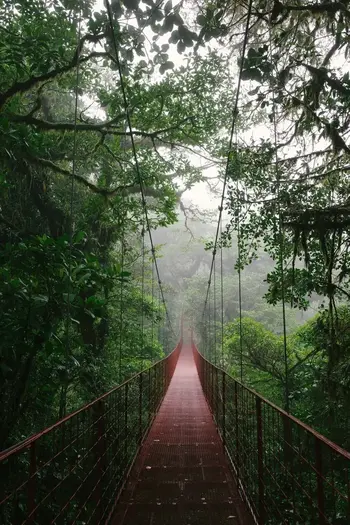
Monteverde Cloud Forest Reserve is a private reserve dedicated to protecting the Monteverde/Santa Elena cloud forest habitat in the Tilarán Mountains of northern Costa Rica. This reserve, along with the adjacent Curi-Cancha Reserve, is famous for its birding opportunities. The Monteverde Cloud Forest is home to keel-billed toucans, more than 30 species of hummingbirds, 10 species of trogons, the famous resplendent quetzal, and many more bird species. The pleasant temperatures in this high-elevation region provide a welcome respite from the oppressive heat of the lowland rainforests. Herpetologists, can take night herping tours from various ecolodges (Night Walk Tour: +50683155002), or book a stay at the Canopy House, which borders the Monteverde Cloud Forest reserve, and has private trails which can be hiked day or night. Various frog species are commonly seen, and sightings of the side-striped palm pitviper (Bothriechis lateralis) are not uncommon. Two-toed sloths (Choloepus hoffmanni) are also commonly seen at night.
Tortuguero National Park
Tortuguero National Park is perhaps the best place in Costa Rica to view sea turtles. Tortuguero offers estuarine and rainforest wildlife tours from the comfort and convenience of a boat. This is one of the best places in Costa Rica to view and photograph the great green macaw (Ara ambiguus). Although traveling to Tortuguero can be difficult and more expensive due to its remoteness and the necessity of hiring boat transportation and tours, this remoteness is one of the park’s best features.
Manuel Antonio National Park
Manuel Antonio National Park is one of the most convenient and accessible parks for viewing a large amount of wildlife in a short amount of time and on a budget. Manuel Antonio offers a blend of rainforest and beach habitats and boasts a large diversity of animal species. Sloths, monkeys, spiny-tailed iguanas (Ctenosaura similis), and even snakes are commonly seen, especially with the help of a guide (or by observing other groups with guides). The downside of Manuel Antonio is that it often gets crowded, sometimes with tourists who don’t respect the rules or wildlife viewing etiquette (you may see people feeding the wildlife right in front of signs saying “Don’t feed the wildlife”). The upside is that the crowds mean there are many eyes spotting wildlife and sharing sightings.
Tárcoles River Bridge
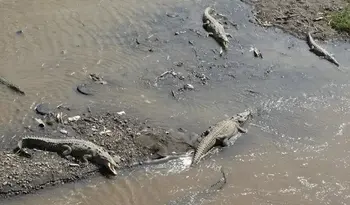
While not a park or preserve, the Tárcoles River Bridge is the most reliable place to see wild crocodiles (Crocodylus acutus). The bridge is a busy road bridge that allows visitors to walk along the edge to view the crocodiles in the river below. The chance of seeing a crocodile here is nearly 100%. There are parking spots and food/souvenir vendors on the north side of the river. You may notice parking attendants here; they are unofficial attendants who watch over your vehicle to protect it from theft and expect a small tip for their services (₡500 is sufficient).
Ecotourism Etiquette
Ecotourists in Costa Rica are privileged to experience the country’s precious wild resources, and we should treat this opportunity as a cherished privilege, not a right to be taken for granted. Remember that you represent your nationality, and it’s important to set a good example and avoid being the "bad apple" that ruins privileges for everyone else.
Most rules of etiquette are common sense, such as not littering, vandalizing, or removing artifacts, flora, or fauna (including seashells on the beach—crabs and other animals use them as homes), and not disturbing wildlife. Some animals are extremely sensitive to human disturbances, and your mere presence can interfere with their natural behaviors, such as hunting, foraging, nesting, and breeding. While some animals are more tolerant of human presence, it’s never okay to feed wildlife, take selfies with wildlife (Costa Rican law), or touch or harass wildlife (gentle handling of small animals like insects or reptiles/amphibians is often tolerated, but collecting/poaching will get you in trouble if caught).
Feeding wildlife is an incredibly common offense, often too widespread for authorities to control effectively. However, ethical ecotourists will avoid feeding wildlife. Feeding wildlife can sometimes harm the animals directly but often causes more significant harm by artificially increasing the population of a species that then predates on other species. For example, if you like sea turtles, don’t feed raccoons, coatis, gulls, and vultures that will ultimately prey on them!
Another important consideration is to avoid trampling vegetation while walking off-trail. It’s easy to assume that the vegetation will quickly grow back due to the abundant rainfall. We’ve all seen jungle explorers and even Costa Rican locals chopping vegetation with machetes, knowing that the plants will regrow quickly, and this might be true for many types of vegetation, especially those exposed to sunlight. However, many plants living on the forest floor of dense canopy primary forests are very long-lived perennials and grow extremely slowly due to the lack of sunlight. Take extra care not to trample these plants.
Finally, think carefully about whether you should make your wildlife observations public. While submitting observations to citizen science websites like iNaturalist.org can greatly contribute to conservation science, consider whether to make the location public (this is an option on iNaturalist.org). Making observations public may encourage others to look for that animal in the same area, which can be beneficial for ecotourism but harmful if it helps poachers or collectors or draws too many visitors to sensitive sites like nests or easily exploited locations such as dens or migratory routes. I encourage everyone to use good judgment and consider the possible consequences before making wildlife observations public. A common way to share beautiful wildlife photos and encourage wildlife appreciation while mitigating the risks of exploitation is to hide the exact location of your observation and only share it with trusted individuals. For example, posting that you found an eyelash viper in Cahuita National Park is public information, but detailing the exact location could lead to the animal being poached. Similarly, noting that you saw a bird nest in Corcovado Park is enough to encourage responsible tourism, but sharing the exact location could result in too many visitors disturbing the nest, possibly causing the mother to abandon it.
Insider’s Guide to Practical Tips for Viewing Wildlife:
8 Practical tips For Finding More Wildlife
In this section, I’ll share some practical tips and tricks for viewing wildlife in Costa Rica that I’ve learned from my own experiences. Whether you’re a seasoned traveler or visiting for the first time, these insights will help you make the most of your wildlife encounters, ensuring that you have a rewarding and memorable experience while respecting the natural environment and its inhabitants. From the best times to venture out to strategies for spotting elusive species, these insider tips will give you an edge in your wildlife adventures.
1. Start with a Local Guide: Begin your adventure with a local guide, even if it's just for a single tour on your first day. While guides are skilled at finding animals and can maximize your sightings, if you’re like me, you'll desire the thrill of spotting wildlife on your own, without a guide, and at your own pace, even if it means fewer sightings. What I like to do is compromise and hire a guide just for the first day or for one tour to learn the best spots, tips, and techniques from the expert. Afterward, I venture out on my own, applying what I’ve learned. This approach saves money compared to hiring guides every day and adds the excitement of independent exploration. There have been times when I was out of my element and couldn’t find much wildlife, only to hire a guide on my last day just to finally realize what I should have been doing all along. In hindsight, hiring the guide on the first day would have likely led to more successful wildlife sightings throughout the trip (and cost me the same amount as hiring on the last day).
2. Move Slowly in the Rainforest: When searching for wildlife, especially herps (reptiles and amphibians) in Costa Rican rainforests, the best advice is to go slow—really slow. Herping in the rainforest is different from herping in the desert. In deserts, wildlife is sparse but easier to spot, so it makes sense to cover more ground. Rainforests, on the other hand, are the opposite...life is everywhere, but it’s much harder to see. Moving quickly means you’re likely walking past many hidden animals. It’s far more effective to slow down to a snail’s pace. If you’re accustomed to herping in deserts, you’ll need to adjust by spending much more time scanning the vegetation. When you know you’re in the right habitat at the right time, don't walk any faster than a tortoise. Take two steps, stop, and thoroughly scan the vegetation from front to back, top to bottom, then repeat.

3. Walk Single File in Groups: When searching for snakes in a group, walk single file. The lead person can focus on the ground to avoid stepping on snakes, while those following can scan low-lying vegetation and trees. To maximize your chances, have each person in the group assigned to look at one side of the trail, so you’re not all searching the same side. Don’t forget to occasionally stop and look behind you to check the other side of leaves and trees. For example, while herping at Yatama Ecolodge, I was with two guides and my partner, who were all ahead of me. Despite their expertise in spotting frogs, they missed a brightly colored snake because it was on the wrong side of a tree. I only spotted it because I happened to look back at the right moment. The lesson here is that even if you’re last in line, taking the time to look backward can reveal something everyone else missed.
4. Search Along Water Sources: Frogs need water to breed and often establish territories near ideal breeding sites. If you’re searching for frogs, these are prime locations. If you’re after snakes or larger carnivorous herps, remember that frogs are a primary food source for many predators. In Costa Rican rainforests, even large fer-de-lance snakes, which you might expect to feed primarily on rodents, are opportunistic frog eaters.
5. Research Your Target Species: Make sure you know whether your target species is nocturnal or diurnal. Don’t be misled by photos you’ve seen—many are staged. For example, red-eyed tree frogs (Agalychnis callidryas) are strictly nocturnal, despite photos showing them during the day. Learn about their preferred habitat, such as whether they are found along creeks, and understand their diet and breeding habits. Animals living in the canopy can be difficult to spot, so if your target species is a canopy dweller, find out if there’s a time of year or day when they descend to the forest floor. For instance, the black-speckled palm pitviper (Bothriechis nigroviridis) is a canopy dweller and rarely seen, even where they are common. In contrast, the side-striped palm pitviper (Bothriechis lateralis) also shares the canopy with B. nigroviridis, but often makes brief excursions to the forest floor at night to feed. Similarly, many species of tree and leaf frogs spend most of their lives high in the canopy but come down to pools of water to breed. One such example is the gliding leaf frog (Agalychnis spurrelli), which spends most of its life in the canopy but occasionally comes down to breed in the numbers. It lasts just a couple nights before they all return to the canopy. This is a species that you'll either see zero, or you'll see a hundred.
6. Watch for Eye Shine at Night: Crocodilians (caimans and crocodiles in Costa Rica) are easy to spot at night by looking for their eye shine. I personally spotted several crocodiles at night at Sierpe River Camp and a caiman at Hacienda Barú using this method. Many nocturnal mammals, such as cats, opossums, kinkajous, and certain tree frogs, also have noticeable eye shine. For the best results, hold your flashlight close to your eyes and look straight down the beam as if aiming a rifle—eye shine often reflects directly back to the light source.
7. Consider Coastal Rainforest Conditions: Coastal rainforests have less moisture due to higher evaporation rates, leading to fewer mosses and epiphytes on trees compared to super-humid inland lowland rainforests. The lack of moss and epiphytes makes the branches look less "busy" and more open, meaning there are fewer hiding spots for creatures, and their camouflage is less effective.
8. Learn the Calls of Your Target Species: Familiarize yourself with the calls of the species you’re seeking. Toucans, for example, are noisy and have easily recognized calls. Red-eyed tree frogs also have distinctive calls that can help you locate them. In fact, experts routinely find frogs by following their calls. Learn Costa Rica's frog calls with the Field Guide to Costa Rica Frogs and Toads ebook, coauthored by Brian Kubicki, owner of the Costa Rican Amphibian Research Center ecolodge and Guayacan rainforest reserve.
Costs and Budgeting for Your Costa Rica Eco-Adventure
Currency and Payment Methods
The currency in Costa Rica is the colón (plural: colones), with the symbol "₡" and the code "CRC." At the time of writing, $1 USD is equivalent to approximately 518 CRC. Common banknotes include denominations of 1,000, 2,000, 5,000, 10,000, and 20,000 colones.
In Costa Rica, the most commonly accepted payment methods are colones (CRC), U.S. dollars (USD), and credit cards. I recommend using all three during your visit. Credit cards are widely accepted, often without unexpected fees (though it's best to confirm with your credit card company), and currency conversions are done at the official bank exchange rate. This should be your preferred payment method as it helps avoid errors, unfavorable exchange rates, and reduces the need to carry large amounts of cash. Additionally, a credit card is essential if you plan to rent a car.
Colones are ideal for everyday transactions such as buying gas, paying road tolls, eating at sodas (small local restaurants), paying taxi or bus fares, buying groceries, paying park entrance fees, and tipping. It’s also a good idea to carry some USD, as certain services—such as tours, lodging, and sometimes private transportation—may require payment in U.S. dollars. If you're from the U.S., bring the amount of USD you anticipate needing. If you're coming from another country, try to obtain USD in advance where you can secure a favorable exchange rate. While most businesses in Costa Rica accept USD, if a price is quoted in CRC, it’s advisable to pay in CRC to avoid potentially unfavorable exchange rates.
To acquire colones, I recommend using a debit card to withdraw cash from ATMs, which generally offer a fair exchange rate, minus a small ATM fee. Outside of the airports (SJO and LIR) and a few large shopping areas, most ATMs are located at banks. Avoid using the exchange booth at Juan Santamaría Airport (SJO), as it typically offers an unfavorable exchange rate. Instead, use the ATM near the luggage carousel after passing through customs. Many ATMs default to Spanish, but often have an option to switch to English. It’s best to avoid asking someone for help to protect your personal information, such as your PIN. In case you encounter an ATM without an English option, it’s helpful to know a few key Spanish terms:
ATM Spanish Terms to Know| English | Spanish |
| Card | Tarjeta |
| PIN | Contrasena |
| Withdraw | Retirar |
| Balance | Saldo |
| Checking Account | Cuenta corriente |
| Savings Account | Cuenta ahorros |
Average Costs for an Ecotourism Trip to Costa Rica
Budgets can vary widely depending on your style. In general, a Costa Rica vacation will be cheaper than a comparable one in the U.S., but don’t expect to be paying super low third world rates. Gas is more expensive than in the U.S.A., food is comparable to U.S.A. prices, and lodging is typically cheaper. Lodging can be found for as cheap as $30 (USD) per night, but can also range into the hundreds per night, depending on where you stay.
Tipping Etiquette in Costa Rica

Tipping in Costa Rica is generally not expected, as it is in the U.S., but it is appreciated, especially since salaries tend to be lower than in many other countries. Colones are preferred for tipping, but U.S. dollars are also widely accepted. In restaurants, a 10% service fee is automatically added to your bill and is distributed among all employees. If you feel your waiter provided exceptional service, you can leave an additional tip in cash directly to them, as there is usually no option to add a tip to your credit card. When parking, you may encounter a “wachman,” an unofficial parking lot attendant who watches your car to protect against theft. It’s customary to acknowledge them when you arrive and to tip them around 500 colones when you return to your vehicle. See the table below for a tipping guide for various services.
Tips for Tipping in Costa Rica| Service | Requires Tip? | How Much? |
| Public Bus Driver | No | N/A |
| Private Car Transportation (limo/shuttle) | Maybe | 0-10% |
| Hotel Front Desk | No | N/A |
| Car Rental Attendant | No | N/A |
| Bell Hop | Yes | $1 (USD) per bag |
| Taxi Driver | Yes | Round up to nearest ₡500-1,000. More if you've requested additional services such as extra wait time |
| Waiter | No | 10% is automatically added to your bill. You can round up to your nearest bill if paying in cash. |
| Private Tour | Yes | $5 per person per tour. Extra if they've gone above and beyond. |
Conclusion: The Importance of Ecotourism in Costa Rica
Costa Rica is a shining example of how ecotourism can play a vital role in preserving the environment and supporting local communities. By choosing ecotourism, visitors not only experience the country’s incredible biodiversity and stunning landscapes but also contribute directly to the protection of these precious wildlands. Ecotourism provides a sustainable source of income for Costa Ricans, allowing them to earn a living by safeguarding their natural heritage rather than exploiting it for timber, resource extraction, or agriculture. Every time you visit a national park, stay at an eco-lodge, or hire a local guide, you’re helping to create economic incentives that prioritize conservation. Your participation in ecotourism strengthens the ongoing efforts to preserve Costa Rica’s rich biodiversity for future generations, ensuring that this small country continues to be a global leader in environmental stewardship. Thank you for choosing to travel responsibly and for being a part of the movement that protects and cherishes our planet’s natural wonders.
Additional Resources for Costa Rica Ecotourism
Further Reading and Websites
U.S. Government
Recommended Apps for Costa Rica Travel
- Waze (navigational app)
- MAPS.ME (downloadable maps available offline)
- Google Translate
- Duolingo (language learning app. Best used before travel, use Google translate during travel)
Welcome to the Video Summary of the Comprehensive Costa Rica Travel Guide
Below, you will find a video summary for each of the main sections in this guide. These videos were AI generated to summarize the content of the comprehensive guide. The table of contents to the left, shows you all sections of this guide, but the links won't function in the video summary tab. To go back to the full guide, click on the "Full Article" tab above.
Chapter 1: Understanding Costa Rica
Understanding Costa Rica
- Geography & Regions
- Provinces
- Climate & Weather
- Biodiversity
- Diverse Ecosystems
- Iconic Species
Chapter 2: Language & Culture
Language & Culture
- Costa Rican Culture
- Local Customs
- Do You Need to Speak Spanish?
- Spanish Words to Know
Chapter 3: Preparing for Your Trip
Preparing for Your Trip
- Travel Documentation
- Vaccines
- Health Considerations
- Food
- Packing Tips
- Cell & Data Service
Chapter 4: Transportation
Transportation
- International Travel
- Ground Transportation
- Domestic Flights
- Taxi Overview
- Bus Overview
Chapter 5: Public & Private Lands
Public & Private Lands
- Parks & Preserves
- Corcovado
- Monteverde Cloud Forest
- Tortuguero
- Manuel Antonio
- Tarcoles River
- Ecotourism Etiquette
Chapter 6: Expert Wildlife Viewing Tips
Expert Wildlife Viewing Tips
Chapter 7: Budget & Payment
Budget & Payment
- Currency and Payment Methods
- ATM Spanish Terms
- Average Costs
- Tipping Guide
Chapter 8: Conclusion
Conclusion
